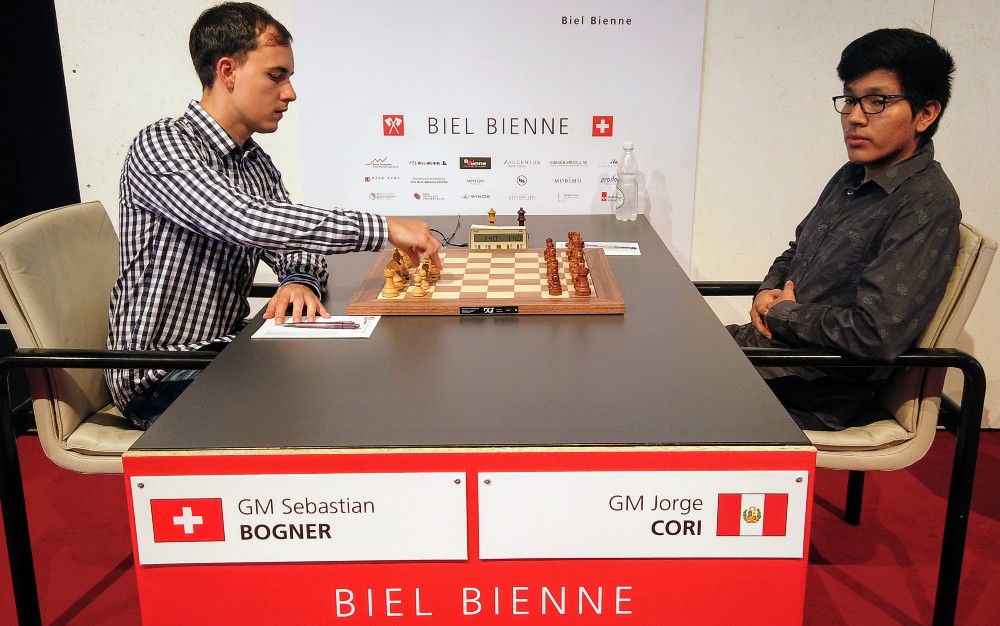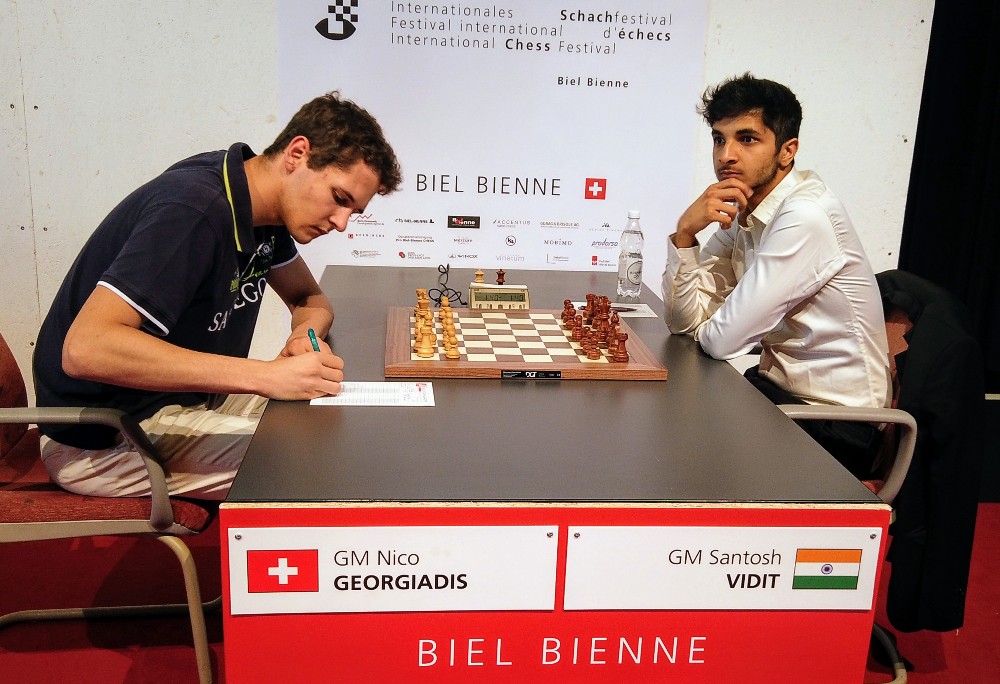The Swiss overshadows Shankland's rook sac!
Before I start with the games, I would like to give a bit of history regarding Nico Georgiadis. In Biel 2017, when only an IM, he was sharing the lead at one point with Harikrishna, Hou Yifan and Etienne Bacrot. In 2018, he held Magnus Carlsen after sacrificing an exchange. Clearly, he is one of the most underrated players in the circuit.
Today, his opponent was an ambitious Vidit Gujarathi, who has recently been playing sharp chess in a bid to become a universal player. The rating gap was nearly 200 points, but Georgiadis didn't care, as he systematically outplayed the second seeded Vidit in an Exchange Gruenfeld to get a crushing advantage. Alas, chess is a tough game, and it isn't over till one of the players resign or is checkmated. With that in mind, I would like to draw your attention to the following position:
It's White to play here, and he has a Gruenfeld endgame that has gone horribly bad for Black. He is currently a piece down for a pawn, and the logical decision would be to take back the knight on a3, which is probably what Vidit was counting on. The opposite coloured bishops and the simplified position mean that the resulting endgame is closer to a draw than a win for White. In fact, in the press conference, both players were calculating the consequences of ♕xe7, and along with the commentators were stupefied in quite a few positions. The objective evaluation is that Black draws after 27.♕xe7? ♛c1+ 28.♔g2 ♝f8!! 29.♕c7 ♞c2! (Check the notes in the game).
Nico played 27.♕xa3?! in the game and couldn't manage to convert an overwhelming position. The best move in this position is something both players didn't mention in their press conference after the game, and in my opinion didn't seriously consider during the game. The fact is that White is winning by force after d6!!.
I'm sure that given a lot of time, both players would have found this. The idea is in itself spectacular — White sacrifices a whole piece in the endgame, with no apparent promotional ideas in sight. However, this is where intuition comes in handy. It took me some time in sober analysis to understand fully why this move works — in this position, the concrete factors are in White's favour. His queen is ideally placed to support the b and d pawns. Black's two pieces are poorly located — the extra knight is located on one of the worst squares on the board, and his bishop is gasping for air. With two pawns on the 6th rank, the Black queen is overloaded as well. I'm sure that you have now understood the purpose of this move: White goes all in with his trumps — his advanced pawns. If he can get a queen of 9 points (potentially two, so make it 18!), Black's extra knight will be worthless.
What about the drawing combination I mentioned above? Surely a similar one can exist? The answer is a vehement 'no'! White wins by a tempo after 27...♛c1+ 28.♔g2 exd6 (28...♝xe5? loses to 29.dxe7. Yet again Black loses by a tempo!) 29.b7! (Passed pawns must be pushed!) ♞c2!?. It appears that if White queens 30.b8=♕+ ♝f8 Black is threatening to play 31...♞e1+ and 32...♛h6 (in the notes to the game a similar idea draws for White in the ♕xe7 lines, as the white queen is worse off on e7!!). But here White has the calm 31.♕f4!
What about other defensive ideas? Well Black has the obvious 27...exd6 in the initial position. Now, after 28.b7! ♛b8 it appears that Black is safe (28.exd6? ♝f8! and it appears difficult to break through.) However, White has a beautiful creeping move to seal the deal — 29.♕g4!
Black is four points up on the material scale, but what are those points doing? The extra piece would have rather taken the place of the queen on b8 and the a-pawn is irrelevant. Note what an important role White's e-pawn is playing — 29...f5 is rendered impossible due to 30.exf6! en passant! Black's pieces are scattered and useless, and there is no defence to 30.♕c8.
The most testing variation is after 27...♝xe5! 28.dxe7!:
Black takes the b8 square under control and it seems White is getting nowhere. I think this is the supposed defence both players must have seen. However, White wins due to the sheer strength of passed pawns! Let's try the natural 28...♛e8. White plays 29.b7! and Black is lacking a good move. If he tries 29...♞b5!?, a desperate attempt to bring the knight back to the battlefield, White has the strong centralizing move 30.♕c5!
Black can't prevent both 31.♗c6 and 31.♕c8. White is clearly winning. The best defence suggested by the engine is 28...♚g7! (instead of 28...♛e8). Now White has to be a bit precise, but he gets the job done by 29.b7 ♛e8 30.b8=♕!! (sacrificing a pawn, but the point is soon seen) 30...♝xb8 31.♕d4+!
Note how strong the e7 pawn is? It takes away the f8 square from the king, and that alone guarantees White an easy win. Now 31...f6 is met by 32.♕d8! ♚f7 33.♗d5+, winning the queen and checkmating soon. The toughest appears to be 31...♝e5!?, but White wins after 32.♕xe5+! ♚g8 33.♕f6! and 34.♗c6 is unstoppable.

Time pressure prevented Nico from playing one of the best games of his life! | Photo: Simon Bohnenblust / Biel Chess Festival
What I am trying to do with this example is to emphasis on the value of quality over quantity — it doesn't really matter how much you have, it matters where and when you have them! Hopefully, this has been a lesson in intuitive sacrifices, the value of a passed pawn and calculation to the readers.
Now, lets return to the other games — one decisive result and two one-sided draws:
Shankland 1-0 Maghsoodloo
Sam has taken some time, but the top seed is finally playing his best chess. His opponent's free fall continues — Maghsoodloo has now lost three classical games in a row without making significant mistakes. With this win Sam catches Vidit at the top. Here are a few critical moments:

Sam's return to 1.e4 paid dividends | Photo: Simon Bohnenblust / Biel Chess Festival
The Richter-Rauzer, Maghsoodloo's choice of defence. Going by this game though, he will need to pick and choose against whom he plays this.
11...b4!? has been the most popular move in the position, but I don't quite like it so much. The reason is that Shankland soon got control of the proceedings. Also, the break feels a little too early. Instead, I have recommended 11...h6!? and 11...♛a5!? as possible improvements in the notes.
White has got a slight pull out of the opening after 15.e5!, but if Black is precise here with ♞fd5! he should have fewer problems than in the game. Instead, 15...dxe5?! is opening the position of the king while it is still stuck in the centre. After 16.♘xe5! White's advantage assumed serious proportions.
Maghsoodloo went 16...♜b7 here, and while I admire his inventiveness, there was a better option in 16...♝c6!, sacrificing a pawn but getting developed and castled soon. Now however, White obtains a stranglehold after 17.♗c4.
Black has blundered with 17...♝b5? (17...♝c8 was a tad better). Can you find a combination to win two pawns? White to play.

A change to a white shirt and 1.e4 are what turned Sam's fortunes around! | Photo: Simon Bohnenblust / Biel Chess Festival
Leko ½-½ Abdusattorov
 The Catalan is one of the most solid openings for White. It forms part of the large and strong fianchetto family in which White builds his strategy mainly around the bishop on g2. Grandmaster Victor Bologan covers all of Black’s replies to the Catalan, some of which can even transpose to other openings such as the Tarrasch System and the Queen’s Indian. Suffice it to say that the Catalan rules!
The Catalan is one of the most solid openings for White. It forms part of the large and strong fianchetto family in which White builds his strategy mainly around the bishop on g2. Grandmaster Victor Bologan covers all of Black’s replies to the Catalan, some of which can even transpose to other openings such as the Tarrasch System and the Queen’s Indian. Suffice it to say that the Catalan rules!Peter has been getting wonderful positions with White, but he has only been able to win one of them. Today, he surprisingly faltered in the endgame against Nodirbek:
It was time to improve the c2 knight with 27.♘d4! The c5 pawn remains tactically defended and White is ready to reposition the d4 knight to b3, after which the win should be a question of when rather than if. Instead, Leko played the defensive 27.♘e4?! and lost all his advantage.
Bogner ½-½ Cori
Both the players were coming off Black games, but Bogner had White this time. He gained considerable pressure, but at the critical juncture he failed to capitalize on an opportunity to improve his pieces to the maximum.

Bogner missed a great chance to improve his tournament standing | Photo: Simon Bohnenblust / Biel Chess Festival
It was time to improve the knight and dark squared in consecutive moves — 35.♘c5! ♜b6!? 36.♗c3!. White has a serious advantage, as Black is struggling for room and co-ordination. Instead, Bogner went 35.♖a1?!, and though he got small chances later, he didn't capitalize on them and a draw was the logical result.
Overall standings
| Rank |
Name |
Games |
Classic |
Rapid |
Blitz |
Total |
| 1 |
GM Sam Shankland |
11 |
7 |
9 |
0 |
16 |
| |
GM Santosh Vidit |
11 |
8 |
8 |
0 |
16 |
| 3 |
GM Peter Leko |
11 |
5 |
10 |
0 |
15 |
| 4 |
GM Jorge Cori |
11 |
5 |
7 |
0 |
12 |
| 5 |
GM Parham Maghsoodloo |
11 |
3 |
8 |
0 |
11 |
| 6 |
GM Nodirbek Abdusattorov |
11 |
5 |
5 |
0 |
10 |
| 7 |
GM Nico Georgiadis |
11 |
3 |
6 |
0 |
9 |
| 8 |
GM Sebastian Bogner |
11 |
5 |
3 |
0 |
8 |
Vidit is joined by Shankland at the top, with Leko the closest to them. Is this going to be a three horse race?
Links



























